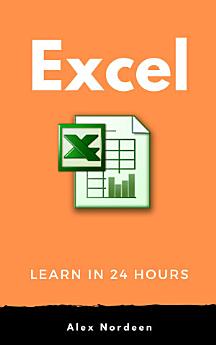Learn Excel in 24 Hours
About this ebook
The book gives a detailed introduction to Excel. It proceeds to teach basic concepts like row, columns, ribbon, worksheet, shortcuts. Later provides a detailed explanation of Formulas, Operators, and Functions. The book also briefly touches the concept of VBA.
Pivot Tables, Connection to external Data Sources included.
The book also includes a case study to Managing personal finance using Microsoft Excel.
Table Of Content
Chapter 1: Introduction
1. What is Microsoft Excel?
2. Why should I learn Microsoft Excel?
3. The difference between excel and CSV file
4. Running Microsoft Excel
5. Understanding the Ribbon
6. Understanding the worksheet (Rows and Columns, Sheets, Workbooks)
7. Customization Microsoft Excel Environment
8. Important Excel shortcuts
Chapter 2: Getting Started
1. Basic Arithmetic
2. Formatting data
3. Setting the print area and printing (Print View)
4. Adding images to spreadsheets
5. Data validation
6. Data filters
7. Group and Ungroup
Chapter 3: Formula & Functions
1. What is a formula?
2. What is a function?
3. Common functions
4. Numeric functions
5. String functions
6. Date Time functions
7. V Lookup function
Chapter 4: Operators
1. What is a Logical Function?
2. What is a condition and why does it matter?
3. IF function example
4. Excel Logic functions
5. Nested IF functions
Chapter 5: Charts
1. What is a chart?
2. Types of charts
3. The importance of charts
4. Step by step example of creating charts
5. Conditional Formatting
Chapter 6: Case Study: Personal Finance Application using Excel
1. Why managing personal finance matters
2. Major components of a personal finance system
3. Using Excel to set personal budgets, record income and expenses
4. Visualizing the data using charts
Chapter 7: Macros
1. What is a macro?
2. Macro Basics
3. Step by step example of recording macros
4. What is VBA?
5. Visual Basic for Applications VBA basics
6. Step by step example of creating a simple EMI calculator
Chapter 8: Connecting Excel to External Data Sources
1. What is external data source?
2. MS Access external data source
3. Web external data source
4. Text file external data source
5. SQL Server external data source
Chapter 9: Pivot Tables
1. What is a pivot table?
2. Step by step tutorial on creating pivot tables
3. 2-Dimensional pivot tables
4. Visualizing pivot table data using charts
Chapter 10: Advanced Charts
1. What is an advanced chart?
2. The importance of advanced charts
3. Step by step example of creating advanced charts
Chapter 11: Excel in the cloud: Office 365
1. Introduction to cloud computing
2. What is Office 365?
3. Advantages of Office 365
4. Disadvantages of Office 365






